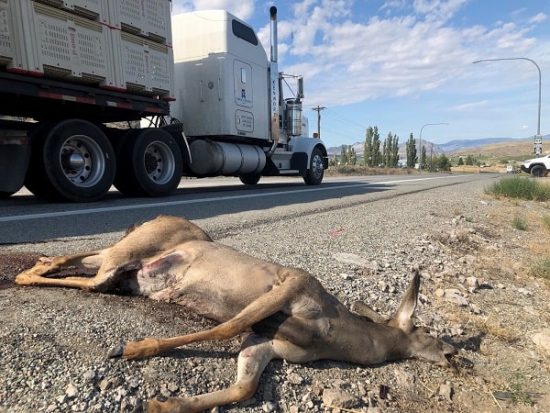
Infrastructure Bill Includes Fish, Wildlife Passage Elements
What’s being termed a “significant investment in wildlife, fish, parks, and tribal lands” has been passed by the US House of Representatives tonight, and one clear winner appears to salmon, deer and other species trying to get around migratory barriers.
“When signed into law, the legislation will provide the nation’s first dedicated resources—$350 million over five years—for state, local, and tribal governments to construct wildlife crossings that reduce human and animal fatalities and injuries caused by the more than 1 million wildlife-vehicle collisions that occur each year,” said Marcia Argust of Pew Charitable Trust.

What’s known as the Infrastructure Investment and Jobs Act, or HR 3684, passed on a 226-208 vote, with a dozen or so infrastructure-minded Republicans joining all of their Democratic colleagues minus the progressive wing of the party. Next step is for President Joe Biden to sign it.
“Another $1 billion —spread equally over five years—will go to states, local governments, and tribes to repair or remove culverts, improving fish survival, and $400 million over five years will further aid fish survival by supporting removal of barriers such as dams,” Argust added.
Whit Fosburgh of the Theodore Roosevelt Conservation Partnership said passage of the bill illustrated lawmakers understood the relation between natural resources and infrastructure.
“The provisions within this comprehensive package are not only worth the investment as we think about the future—many are long overdue,” he said. “We look forward to President Biden signing and enacting this legislation that makes a strong commitment to conservation.”
A TCRP press release outlined these fish-and-wildlife-centered elements in the whopping $1.2 trillion bill:
- $350 million for a first-of-its-kind grant program to construct wildlife-friendly roadway crossings and reconnect fragmented migration corridors.
- $250 million for the Legacy Roads and Trails Remediation Program to improve access to Forest Service public lands and safeguard fish and wildlife habitat from harmful runoff and pollutants caused by roads in disrepair.
- Reauthorization of the Sport Fish Restoration and Boating Trust Fund, which pays for fisheries conservation, access improvements, and education for anglers and boaters.
- $14.65 billion for the Clean Water State Revolving Fund Program, which supports estuary restoration and stormwater management projects.
- $400 million for WaterSMART grants, with $100 million set aside for natural infrastructure solutions that enhance resilience to drought and wildfires, facilitate water conservation, create new habitat, and improve water quality.
- Significant investments in programs aimed at enhancing the resiliency of Western watersheds to climate change and drought, including $300 million to implement the Colorado River Drought Contingency Plans, $3.2 billion to modernize aging agricultural infrastructure and generate benefits for fish and wildlife, and $50 million to support ongoing Endangered Species recovery efforts that sustain habitat for native fish.
While the latest version of the Build Back Better bill included $400 million for hatcheries, no funds were allocated in Friday evening’s infrastructure package. Stay tuned for reconciliation talks between the chambers of Congress.
“We thank our many conservation champions and Congress as a whole for passing the historic, bipartisan Infrastructure Investment and Jobs Act,” said Tony Wasley, director of the Nevada Department of Wildlife and president of the Association of Fish and Wildlife Agencies. “By reauthorizing core systems of conservation and establishing new, groundbreaking programs, Congress and the White House have once again shown their commitment to working across the aisle to address modern-day natural resource challenges and have set the stage for collaborative conservation and restoration of our nation’s fish and wildlife species and habitats.”
A press release from Washington US Rep. Derek Kilmer’s (D-4) office pointed to the act’s $1 billion for a new federal Transportation Department program “aimed at removing, replacing or restoring culverts, which will enable the recovery of salmon passage and habitats,” which he worked on with the state’s junior US Senator, Maria Cantwell, $172 million for NMFS’s Pacific Coastal Salmon Recovery Fund and $89 million for Puget Sound Geographic Program grants meant to boost water quality, fish passage and salmon habitat.
“I’m also thrilled that this bill includes initiatives I led to help recover our salmon populations,” said Kilmer. “The Infrastructure Investment and Jobs Act will create a new program that I proposed with Senator Cantwell aimed at removing, replacing, and restoring culverts, which will improve fish passage and enable habitat recovery. This will be the first federal program devoted entirely to culvert restoration.”
Montana’s Backcountry Hunters and Anglers was cheered by funding for land reclamation aspects of the infrastructure bill, including $11.29 billion for a coal mine cleanup program.
“The road to achieving this conservation victory was neither smooth nor simple,” said Land Tawney, BHA president and CEO. “Yet our House leaders persevered. In the name of our public lands and waters, our fish and wildlife populations, and our shared outdoor traditions, American hunters and anglers have reason to celebrate this moment. And together we thank the House of Representatives for making it possible for us to achieve it.”
